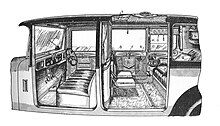A limousine (or limo) is a luxury sedan or saloon car, especially one with a lengthened wheelbase or driven by a chauffeur. The chassis of a limousine may have been extended by the manufacturer or by an independent coachbuilder. These are called "stretch" limousines and are traditionally black or white. Limousines are usually liveried vehicles, driven by professional chauffeurs. As the most expensive form of automobile ground transportation, limousines are culturally associated with extreme wealth or power and are commonly cited as examples of conspicuous consumption. Among the less wealthy, limousines are often hired during special events (most commonly weddings and funerals).
 While some limousines are owned by individuals, many are owned by governments to transport senior politicians, by large companies to transport executives, and by broadcasters to transport guests.[citation needed] Most stretch limousines, however, operate as livery vehicles, providing upmarket competition to taxicabs. Builders of stretch limousines purchase stock cars from manufacturers and modify them, and most are in the United States and Europe and cater mainly to limousine companies. Few stretch limousines are sold new to private individuals. In addition to luxuries, security features such as armoring and bulletproof glass are available.
While some limousines are owned by individuals, many are owned by governments to transport senior politicians, by large companies to transport executives, and by broadcasters to transport guests.[citation needed] Most stretch limousines, however, operate as livery vehicles, providing upmarket competition to taxicabs. Builders of stretch limousines purchase stock cars from manufacturers and modify them, and most are in the United States and Europe and cater mainly to limousine companies. Few stretch limousines are sold new to private individuals. In addition to luxuries, security features such as armoring and bulletproof glass are available.The first automobile limousine, built in 1902, was designed so the driver sat outside under a covered compartment.[1] The word limousine is derived from the name of the French region Limousin, because this covered compartment physically resembled the cloak hood worn by the shepherds there. An alternate etymology has the chauffeur wearing a Limousin-style cloak in the open driver's compartment, for protection from the weather.[2][3][4]
The first “stretch limousine” was created in Fort Smith, Arkansas around 1928 by a coach company named Armbruster. These cars were primarily used to transport famous “big band” leaders, such as Glenn Miller and Benny Goodman, and their bands and equipment. These early stretch limousines were often called “big band buses”.[4]
[edit] Limousine types
The limousine body style has a divider separating the driver from the rear passenger compartment.[2] This partition usually contains a sliding (often soundproof) glass window so that conversations between passengers in the rear compartment may be kept private from the chauffeur. Communication with the driver is possible either by opening the window in the partition or by using an intercom system.[edit] Traditional
Traditionally, the limousine has been an extension of a large car. A longer frame and wheelbase allow the rear passenger compartment to contain the usual forward-facing passenger seat but with a substantial amount of foot room — more than is actually needed. Usually then two "jump seats" are mounted, facing rearward behind the driver. These seats fold up when not in use. In this way, up to five persons can be carried in the aft compartment in comfort, and up to two additional persons carried in the driver's compartment, for a total capacity of seven passengers in addition to the driver. This type of seat configuration has however become less popular in recent limousines, although this design without the two front passenger seats is still characteristic of London's famous Black Cabs.



No comments:
Post a Comment